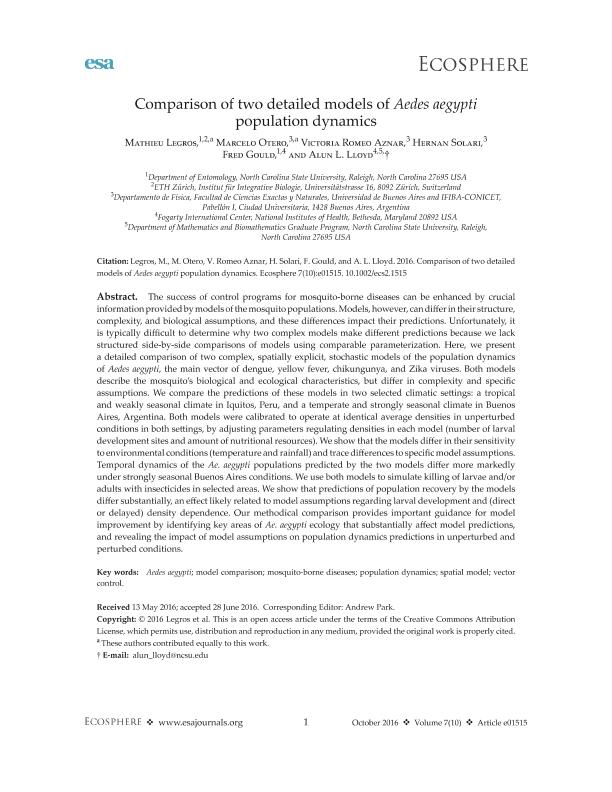Artículo
Comparison of Two Detailed Models of Aedes aegypti Population Dynamics
Legros, Mathieu; Otero, Marcelo Javier ; Romeo Aznar, Victoria Teresa
; Romeo Aznar, Victoria Teresa ; Solari, Hernan Gustavo
; Solari, Hernan Gustavo ; Gould, Fred; Lloyd, Alun L.
; Gould, Fred; Lloyd, Alun L.
 ; Romeo Aznar, Victoria Teresa
; Romeo Aznar, Victoria Teresa ; Solari, Hernan Gustavo
; Solari, Hernan Gustavo ; Gould, Fred; Lloyd, Alun L.
; Gould, Fred; Lloyd, Alun L.
Fecha de publicación:
10/2016
Editorial:
John Wiley & Sons
Revista:
Ecosphere
ISSN:
2150-8925
Idioma:
Inglés
Tipo de recurso:
Artículo publicado
Clasificación temática:
Resumen
The success of control programs for mosquito-borne diseases can be enhanced by crucial information provided by models of the mosquito populations. Models, however, can differ in their structure, complexity, and biological assumptions, and these differences impact their predictions. Unfortunately, it is typically difficult to determine why two complex models make different predictions because we lack structured side-by-side comparisons of models using comparable parameterization. Here, we present a detailed comparison of two complex, spatially explicit, stochastic models of the population dynamics of Aedes aegypti, the main vector of dengue, yellow fever, chikungunya, and Zika viruses. Both models describe the mosquito?s biological and ecological characteristics, but differ in complexity and specific assumptions. We compare the predictions of these models in two selected climatic settings: a tropical and weakly seasonal climate in Iquitos, Peru, and a temperate and strongly seasonal climate in Buenos Aires, Argentina. Both models were calibrated to operate at identical average densities in unperturbed<br />conditions in both settings, by adjusting parameters regulating densities in each model (number of larval development sites and amount of nutritional resources). We show that the models differ in their sensitivity<br />to environmental conditions (temperature and rainfall) and trace differences to specific model assumptions.<br />Temporal dynamics of the Ae. aegypti populations predicted by the two models differ more markedly under strongly seasonal Buenos Aires conditions. We use both models to simulate killing of larvae and/or adults with insecticides in selected areas. We show that predictions of population recovery by the models differ substantially, an effect likely related to model assumptions regarding larval development and (direct<br />or delayed) density dependence. Our methodical comparison provides important guidance for model improvement by identifying key areas of Ae. aegypti ecology that substantially affect model predictions, and revealing the impact of model assumptions on population dynamics predictions in unperturbed and perturbed conditions.<br /><br />
Archivos asociados
Licencia
Identificadores
Colecciones
Articulos(IFIBA)
Articulos de INST.DE FISICA DE BUENOS AIRES
Articulos de INST.DE FISICA DE BUENOS AIRES
Citación
Legros, Mathieu; Otero, Marcelo Javier; Romeo Aznar, Victoria Teresa; Solari, Hernan Gustavo; Gould, Fred; et al.; Comparison of Two Detailed Models of Aedes aegypti Population Dynamics; John Wiley & Sons; Ecosphere; 7; 10; 10-2016; 1-19
Compartir
Altmétricas



